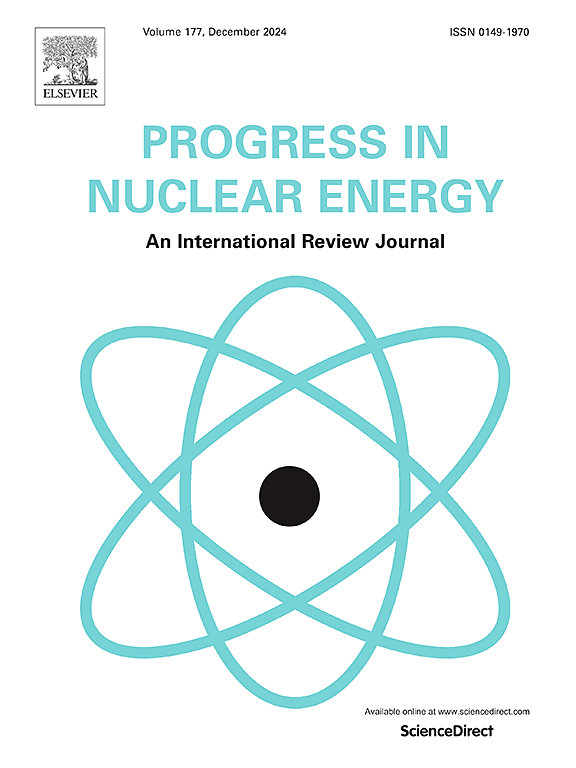Experimental study on the heat transfer characteristics of steam-water two-phase flow in a 2×2 wire-wrapped rod bundle
IF 3.2
3区 工程技术
Q1 NUCLEAR SCIENCE & TECHNOLOGY
引用次数: 0
Abstract
The Supercritical Water-Cooled Reactor (SCWR) is recognized as a promising nuclear reactor design owing to its elevated thermal efficiency and economic advantages. During transient operations or accident scenarios, reactor cores may experience subcritical pressure conditions. Therefore, the heat transfer characteristics of steam-water two-phase flow under subcritical pressure are crucial for the thermal-hydraulic design and safety assessment of SCWRs. The heat transfer characteristics of steam-water two-phase flow in a 2 × 2 wire-wrapped rod bundle were experimentally investigated. The effects of system parameters on heat transfer characteristics were analyzed. As the heat flux increased, the wall temperature in the single-phase region increased accordingly, but the heat transfer coefficient remained unchanged. In the saturated boiling region, the wall temperature stayed relatively constant, but the heat transfer coefficient improved with heat flux. The mass flux had a relatively weak effect, whereas an increase in pressure led to higher values in the wall temperature and heat transfer coefficient within the two-phase region. Several heat transfer correlations were selected for evaluation. It was found that the Kandlikar (1990) correlation showed the highest accuracy for saturated flow boiling. The critical heat flux associated with heat transfer deterioration was also examined. As the pressure increased, the critical heat flux and critical steam quality decreased, suggesting that higher pressure will exacerbate heat transfer deterioration.
2×2包丝棒束中蒸汽-水两相流换热特性的实验研究
超临界水冷堆(SCWR)由于其较高的热效率和经济优势而被公认为一种有前途的核反应堆设计。在瞬态运行或事故情况下,反应堆堆芯可能经历亚临界压力条件。因此,亚临界压力下蒸汽-水两相流的换热特性对超临界水堆的热工设计和安全性评价至关重要。实验研究了2 × 2线包棒束中蒸汽-水两相流的换热特性。分析了系统参数对传热特性的影响。随着热流密度的增大,单相区壁面温度相应升高,但换热系数保持不变。在饱和沸腾区,壁面温度保持相对恒定,但传热系数随热流密度的增大而增大。质量通量的影响相对较弱,而压力的增加导致两相区域壁面温度和换热系数的升高。选择几个传热相关性进行评估。发现Kandlikar(1990)相关对饱和流沸腾具有最高的精度。研究了与传热恶化相关的临界热流密度。随着压力的增加,临界热流密度和临界蒸汽质量降低,表明压力的升高会加剧换热恶化。
本文章由计算机程序翻译,如有差异,请以英文原文为准。
求助全文
约1分钟内获得全文
求助全文
来源期刊

Progress in Nuclear Energy
工程技术-核科学技术
CiteScore
5.30
自引率
14.80%
发文量
331
审稿时长
3.5 months
期刊介绍:
Progress in Nuclear Energy is an international review journal covering all aspects of nuclear science and engineering. In keeping with the maturity of nuclear power, articles on safety, siting and environmental problems are encouraged, as are those associated with economics and fuel management. However, basic physics and engineering will remain an important aspect of the editorial policy. Articles published are either of a review nature or present new material in more depth. They are aimed at researchers and technically-oriented managers working in the nuclear energy field.
Please note the following:
1) PNE seeks high quality research papers which are medium to long in length. Short research papers should be submitted to the journal Annals in Nuclear Energy.
2) PNE reserves the right to reject papers which are based solely on routine application of computer codes used to produce reactor designs or explain existing reactor phenomena. Such papers, although worthy, are best left as laboratory reports whereas Progress in Nuclear Energy seeks papers of originality, which are archival in nature, in the fields of mathematical and experimental nuclear technology, including fission, fusion (blanket physics, radiation damage), safety, materials aspects, economics, etc.
3) Review papers, which may occasionally be invited, are particularly sought by the journal in these fields.
 求助内容:
求助内容: 应助结果提醒方式:
应助结果提醒方式:


